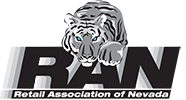Retail is an Economic Driver
By Andy Peterson
When thinking about economic drivers few members of the general public think about the retail industry. They should; the retail industry is our nation’s largest private employer. According to the National Retail Federation, the industry contributes $3.9 trillion dollars to our annual gross domestic product, and it employs 52 million Americans. Retail is a quiet giant most take for granted. Whatever one may or may not think of the retail industry, it supplies everything we use from day to day. Without it we would have limited access to food, medicines, clothing, and any number of necessities that support our lives.
In many ways the industry itself serves as a barometer for the health of the economy itself. Recently, the National Retail Federation released the holiday sales numbers. It was somewhat surprising that year over year numbers increased by 8.3 percent to $789.4 billion in the time of a worldwide pandemic. Had the numbers been underwater there may have been a collective shudder that sent investors fleeing and the rest of us wondering what kind of economic uncertainty might be headed our direction. However, the numbers have served as a comfortable sense of optimism that the economy will continue to perform. Few other industries offer such platforms for gaging the health of country.
Most can be assured the “near future” economy to be stable. The barometer has given some assurance of forward growth and increased economic activity. Unforeseen events can still surprise us all. Witness the recent worldwide pandemic that quickly turned over the apple cart and upset markets. Yet, even in times of great uncertainty – such as we experienced in late second quarter of 2020 – retail led the world back to certainty. Other industries took their cues from the resilience, creativity, and leadership of those in the retail industry. When more people get vaccinated, as will surely happen in time, it is likely we’ll experience stronger economic growth.
Interestingly, ten of the top 100 retailers in the U.S. operate in Nevada. Eight of them are RAN members. These include Walmart ($523.96 billion), Amazon ($250.0 billion), Kroger Co. ($122.28 billion), Walgreens Boots Alliance ($136.86 billion), Home Depot ($110.54 billion), CVS ($88.51), Target ($77.13 billion), and Lowe’s ($72.15 billion). This is not to discount the hundreds of thousands of small businesses which have carved a niche out and have made a go of it. These “mom & pops” should be complimented for providing jobs and contributing to the economy in a manner which can only be described as substantial.
Given Retail’s heft, it’s ability to predict near term economic certainty, and its large private employment base, considerable consideration ought to be given on several fronts. This includes prioritizing vaccinations for retail employees and legislative consideration in the 2021 session. Governor Sisolak has already given legislators priority access to vaccinations – they were given vaccination priority over retail workers who have been tireless in making sure the general public has access to goods and service throughout the pandemic. Secondly, the legislature ought to resist over regulating the industry as our neighbor to the west has done. Last session there were bills introduced which would have moved us in California’s direction. This session, sensitivity should be administered to both retail employer and employee.
Retail is a big deal in America, and it’s a big deal in Nevada. Its time we all give it the respect it deserves.

